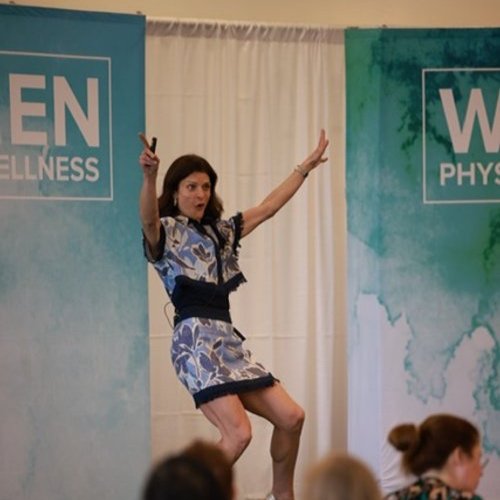Transform Tolerance: Empowering Women Physicians to Lead with Emotional Authority
Our program teaches women doctors how to turn emotional stress into leadership power. Instead of just trying to "push through" hard feelings like frustration or burnout, you'll learn how to understand these feelings and use them to grow. We call this Transform Tolerance.
Transform Tolerance.
You’ll discover seven types of emotional stress and how each type affects your work with patients, your team, and yourself. For each one, you’ll learn clear steps to go from reacting to responding with confidence and care.
The coaching tools in this course are based on real strategies used by Dr. Ali Novitsky from The Fit Collective® over the past 8 years. These tools come directly from the Transform® Program—a 12-month evidence-based lifestyle medicine and coaching program designed for physicians.
One of the most powerful tools taught in the Transform® Program is distress tolerance. This means learning how to handle emotional stress in healthy, effective ways. Instead of avoiding or ignoring hard feelings like frustration, fear, or overwhelm, Transform® teaches you how to understand them, learn from them, and use them as a guide to grow.
We believe that distress tolerance is a core focus of preventing burnout. When doctors know how to recognize and work with their emotions, they can stay calm under pressure, make better decisions, and protect their energy. This emotional strength helps them stay in medicine longer, feel more fulfilled, and support their patients with greater presence and empathy.—a 12-month evidence-based lifestyle medicine and coaching program designed for physicians.




Proven Results from the Transform® Program:
Doctors who went through the Transform® Program shared how their skills and confidence changed before and after the course. Here's what we learned:
Every single skill we measured got better after 6 months. That means 100% of the doctors improved in areas like communication, self-care, and leadership.
Doctors felt better in 12 key areas including how they handle stress, coach patients, and feel connected to their purpose.
The average improvement was between +1.4 to +2.3 points on a 5-point scale. That means doctors moved from "sometimes" to "often" or even "almost always" feeling skilled and confident.
What got better the most?
Doctors felt much more able to help patients make lasting health changes (+2.33 points)
They became kinder and less judgmental toward patients (+1.92 points)
They felt more confident talking about food, exercise, and healthy habits (+1.83 points)
They learned how to use coaching questions and motivational interviewing (+1.83 points)
They felt closer to their purpose as a healer (+1.58 points)
These numbers came from 100 doctors who took the course. The changes were so big, there's almost no chance they happened randomly. That means the program really works!
More Good News: Doctors Stayed in Their Jobs
Doctors who completed the Transform® Program were more likely to stay in medicine and feel happy at work. Here's what they reported:
84% said they were more likely to stay in their job.
84% also said they were less likely to leave medicine.
They felt more job satisfaction when focusing on what they could control, rather than getting overwhelmed.
This means the program helps keep good doctors in the field, which saves hospitals a lot of money and keeps patients getting great care.
Participant Reflections
"I feel like a true model of health."
This program gave me the confidence and authenticity to walk the talk. I can now tell my patients with full integrity: these practices truly work.
"I’m more present and patient—with myself and my patients."
Transform® helped me manage my own stress better, which has translated directly into how I show up in my clinical care.
"Perfection isn’t required—just progress."
The program shifted my mindset. I now guide my patients toward sustainable, incremental changes instead of all-or-nothing thinking.
"My clinical conversations have completely changed."
I now use coaching techniques like open-ended questions and curiosity to truly connect with patients and support lasting change.
"I’ve found balance—and I’m sharing that with my patients."
Transform® taught me new strategies that I not only apply in my own life, but model and pass along to those I care for.
Fun fact: Replacing one doctor can cost up to $1 million. If Transform® helped keep 81 doctors in their jobs, that could save hospitals between $40 and $81 million. That means the program really works! and were confirmed with t-statistics greater than 11 and p-values smaller than 0.00000000001—showing very strong and reliable results. feel healthier, stronger, and more connected to their purpose. The Transform® Program—a 12-month coaching and lifestyle training program—has proven that these strategies work. Doctors who went through Transform® showed big improvements in confidence, communication, and job satisfaction. Many stayed in medicine longer and felt better doing it.




Where Do the Distress Types Come From?
The seven distress types were discovered through coaching thousands of high-achieving women doctors over many years. These patterns showed up again and again during real-life clinical situations, team conflicts, and personal struggles with burnout.
Instead of treating these responses as "bad behavior" or signs of weakness, this model sees them as protective patterns. They helped doctors survive difficult environments but now need to be reshaped into healthy, powerful leadership tools.
Each distress type is based on a common emotional intolerance—like the fear of being vulnerable or not being good enough. When we name and understand these patterns, we can work with them instead of against them.
Practice Gap
Many women doctors work in very busy and emotional places. They often feel stressed, frustrated, or worn out. But they aren't always given the tools to understand or manage these feelings. This can cause problems like:
Fighting with team members
Feeling alone or not supported
Being too hard on themselves
Missing signs that patients need emotional support
Doctors need a simple, helpful way to understand their feelings so they can stay connected to their purpose and care for others.
Learning Objectives
By the end of this course, you will be able to:
Discover your unique stress response type and learn what to do about it.
Recognize your emotional reactions at work and what might be causing them.
Reframe your thinking to understand these feelings as helpful signals.
Respond in healthy, strong ways that help you and others.
Improve how you work with patients, especially in tough or emotional moments.
Build trust with your team by handling stress calmly and kindly.
Create strong boundaries that protect your energy and purpose.
Program Features
✅ Real-life examples and coaching strategies for each distress type
✅ Quiz find your personal distress type
✅ Tools to help you pause, plan, and respond better
✅ Tools for feeling less numb, angry, rushed, or overwhelmed
✅ Designed for women doctors who lead in high-pressure places
Topics Covered
Each session focuses on one of the seven distress types:
Isolation Distress — Feeling alone or unable to ask for help
Assertive Distress — Getting angry or frustrated easily
Impulsivity Distress — Making fast choices to avoid feeling stuck
Control Distress — Needing things to be perfect or predictable
Validation Distress — Wanting approval to feel good enough
Numbness Distress — Shutting down or feeling flat
Catastrophizing Distress — Always expecting the worst to happen
Next Steps
✅ Take The Quiz. Please Note That You Will Not Get Your Results Right Away.
✅ Once we have met our goal submissions, you will be emailed your result and invited to attend our workshop(s)
✅ This is the first step in us validating our tool and refining our coaching strategies
Outcome Measures for Transform Tolerance Training
1. Knowledge & Self-Awareness Growth
You’ll gain insight into how stress shows up in your work—and how to work with it instead of against it.
What We Measure:
Ability to identify your personal stress subtype
Awareness of your emotional reactions at work
Skill in reframing stress as helpful feedback
Goal: Most participants show a +1.5 point increase (on a 5-point scale) in self-awareness and emotional insight.
2. Behavioral Application in Real Life
You’ll learn tools that you’ll actually use—in the clinic and beyond.
What We Track:
% of participants using coaching prompts weekly
% reporting stronger boundaries at work
% applying distress tools during real-time stress
Goal: 70–80% of participants report regular use of new skills.
3. Clinical and Team Impact
This training isn’t just personal—it transforms how you show up for patients and peers.
Measured Through:
“I feel more present with patients during hard conversations.”
“I respond to conflict at work with more calm and confidence.”
“I’ve become a better listener and leader.”
Goal: Average score increase of +1.5 points across all impact areas.
4. Burnout Reduction and Purpose Alignment
We don’t treat burnout with bubble baths—we build real emotional resilience.
We Measure:
Burnout symptoms before and after the program
Feelings of connection to your professional purpose
Intentions to stay in your job or in medicine
Goal:
20% drop in burnout symptoms
85% report greater job satisfaction and clarity
Stronger connection to why you became a healer in the first place
5. Organizational ROI (For Group & System Partners)
Institutions love that Transform® delivers results worth investing in.
Measured Through:
% of physicians who remain in their roles after 6–12 months
Projected cost savings from avoided turnover
CME certificate completion rate
Goal:
80–90% retention rate
Estimated savings: $40M–$81M for every 100 participating physicians
90%+ CME completion rate
References
Creswell JD. (2019). Mindfulness interventions. Annual Review of Psychology, 70:491–516. https://doi.org/10.1146/annurev-psych-010418-102837
Dyrbye LN, et al. (2020). Physician burnout: Contributions, consequences, and solutions. J Intern Med, 288(6): 782–800. https://doi.org/10.1111/joim.13174
Porges SW. (2021). Polyvagal theory and the vagus nerve: Leveraging neurophysiology to improve mental health. Front Psychol, 12:688850. https://doi.org/10.3389/fpsyg.2021.688850
Shanafelt TD, et al. (2019). Executive leadership and physician well-being. Mayo Clin Proc. 94(4): 683–693. https://doi.org/10.1016/j.mayocp.2018.10.020
West CP, Dyrbye LN, Shanafelt TD. (2019). Physician burnout: contributors, consequences and solutions. Journal of Internal Medicine, 283(6), 516–529. https://doi.org/10.1111/joim.12827
